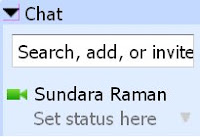In it, in this page, there was an example about risk taking and avoidance. A simplified version of it is:
Which of these options do you think is very risky? Which one is the least risky to invest in?Now, if you have any idea about this thing called diversification at all, you would immediately say the answer - the last one is the least risky.
1. SAIL
2. SAIL & TISCO
3. SAIL & HLL
4. HLL, TISCO, ACC & Infosys
The first one here is very risky - you bet all your money on a single horse.
The second one is slightly better: you place your money on two different companies, but... they are in the same industry (steel), so a problem in the industry itself (which happens ever so often) would still affect you.
In the third one, you still bet on two companies, but the risk is reduced, possibly by a lot. This is because the two companies deal with widely differing fields, so the chance that both of them will fail you together is quite less.
The fourth one is perhaps the safest. Quoting from the tutorial itself,
All these four stocks are leaders in their sectors. The sectors almost cover the entire spectrum of the market. At least two of them will be doing well.
So, let's begin.
Assume that the probability that SAIL's shares will yield good returns and will not fail you is P(S), the same for TISCO is P(T) and that for HLL is P(H).
Now, if you have bought the shares of SAIL and TISCO, the probability that either of them will yield you good returns is
P(S U T)
which, as we know from our high school math, can be written as:
P(S U T) = P(S) + P(T) - P(S ∩ T)
Here, P(S ∩ T) represents the amount of correlation between the yields of SAIL and TISCO - the probability that both companies will give you good yield. And this is where the difference comes between case 2 and case 3. In case 3, we have,
P(S U H) = P(S) + P(H) - P(S ∩ H)
Now, the conditions so that neither SAIL and TISCO fail you are:
1. When neither company does anything stupid
2. When steel industry is going well and
3. When entire economic situation is good
And the conditions for both SAIL and HLL give you good yield are:
1. When neither company does anything stupid
2. When steel industry is going well and the household items market is going well
3. When entire economic situation is good
The two seem quite similar, except for the second point. But that small difference can make a large difference to your life. Heck, it might even decide the difference between luxury and bankruptcy!
Ok, that dramatism was unwarranted, but you get the point. The probability that two unrelated industries will be very bright together is somewhat less than the probability that just one industry become bright. P(S ∩ T) is a little more than P(S ∩ H).
From the above analysis, it is quite obvious that the lesser the value of (S ∩ H), the better are your chances of success. One way to achieve this is, as we did above, to choose industries that are less correlated with each other.
However, while writing this, it occurred to me that P(S ∩ H) will be even lesser if the two industries were competing in some sense (in simplistic terms, think car and bike industry, which in some ways are competing with each other - though this is not a perfect example). In such a case, however, an increase in P(S) would decrease P(H), and vice versa. This is due to the very nature of the industries we chose - each one negatively affects the other.
So, the choice is between choosing
* uncorrelated industries so that P(S) and P(H) can increase simultaneously, but P(S ∩ H) is not quite less, and
* competing industries so that P(S) and P(H) negatively influence each other, but P(S ∩ H) is very less
Obviously, there is no single answer: it depends on P(S), P(H) and the trend of P(S ∩ H). There is an equilibrium point: on one side of it, the first strategy works better, while on the other side, the second works better. Do your math and invest wisely. :)
2. When steel industry is going well and
3. When entire economic situation is good
And the conditions for both SAIL and HLL give you good yield are:
1. When neither company does anything stupid
2. When steel industry is going well and the household items market is going well
3. When entire economic situation is good
The two seem quite similar, except for the second point. But that small difference can make a large difference to your life. Heck, it might even decide the difference between luxury and bankruptcy!
Ok, that dramatism was unwarranted, but you get the point. The probability that two unrelated industries will be very bright together is somewhat less than the probability that just one industry become bright. P(S ∩ T) is a little more than P(S ∩ H).
When we apply this to the above two equations, we see that P(S U T) becomes less than P(S U H), or to put it in optimistic terms, the probability that the stocks fail someone who diversified more, is quite less than the probability that someone who didn't diversify effectively regrets his decision. Thus, good diversification reduces your risk and increases the probability that you will have a successful yield.
From the above analysis, it is quite obvious that the lesser the value of (S ∩ H), the better are your chances of success. One way to achieve this is, as we did above, to choose industries that are less correlated with each other.
However, while writing this, it occurred to me that P(S ∩ H) will be even lesser if the two industries were competing in some sense (in simplistic terms, think car and bike industry, which in some ways are competing with each other - though this is not a perfect example). In such a case, however, an increase in P(S) would decrease P(H), and vice versa. This is due to the very nature of the industries we chose - each one negatively affects the other.
So, the choice is between choosing
* uncorrelated industries so that P(S) and P(H) can increase simultaneously, but P(S ∩ H) is not quite less, and
* competing industries so that P(S) and P(H) negatively influence each other, but P(S ∩ H) is very less
Obviously, there is no single answer: it depends on P(S), P(H) and the trend of P(S ∩ H). There is an equilibrium point: on one side of it, the first strategy works better, while on the other side, the second works better. Do your math and invest wisely. :)


